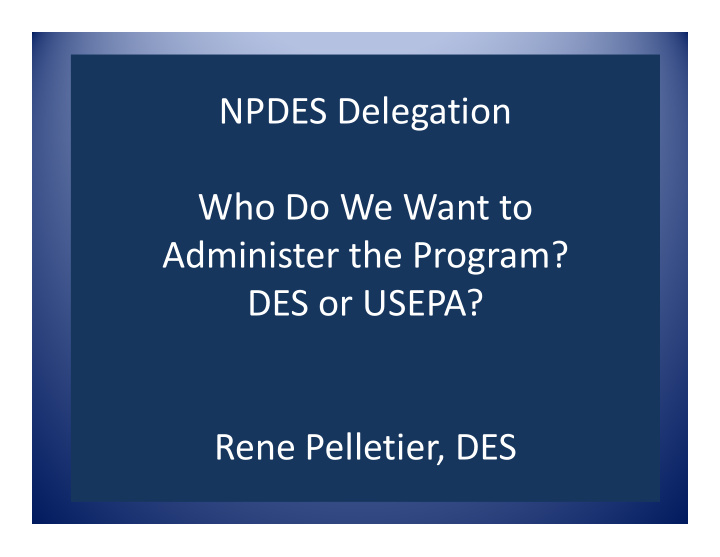



NPDES Delegation Who Do We Want to Administer the Program? DES or USEPA? Rene Pelletier, DES
NPDES - Background Section 402 of the Clean Water Act is the National Pollutant Discharge Elimination System (NPDES) permitting program Control of Point Source Discharges of wastewater and stormwater to protect designated uses of surface waters Uses include fishing, swimming, water supply, aquatic life and wildlife
NH Program NH is one of fours states not delegated to administer the NPDES Program DES reviews and certifies that the EPA issued federal permit meets NH water quality standards DES adopts some federal permits as state permits
NH Adopted Permits Municipal wastewater treatment plant individual permits (53); Industrial individual permits (29); Municipal wastewater treatment plant general permit (17); Non-contact cooling water general permit (2) Hydroelectric generating facilities general permit (31) Potable water treatment facility general permit (5); and Remediation general permit (8)
Permits Only Issued as EPA (federal) Permit Pesticide general permit (2); Vessel general permit (5) and Small Vessel general permit (7); Concentrated Animal Feeding Operation (1); Dewatering general permit (10); Multi-Sector general (Stormwater) permit (325); Construction general (Stormwater) permit (352); and MS4 general (Stormwater) permit (44)
Current DES Role DES monitors surface waters, conducts modeling and assists EPA in development of water quality based permit limits. DES inspects facilities adopted as state permits and shares compliance/enforcement with EPA. DES provides limited outreach on federal stormwater program but does not have statutory authority to issue stormwater permits.
Current DES Role DES assists EPA with industrial pretreatment program. DES provides technical assistance to municipal wastewater treatment facility operators and administers the operator certification and training program.
Current EPA Role EPA currently takes the lead on applications, technology based limits, drafting permits and fact sheets. EPA takes the lead on public notices and hearings, response to public comments, final permit issuance and their Environmental Appeals Board (EAB) in DC responds to permit appeals. EPA administers the federal stormwater program which includes outreach, compliance and enforcement on the 3 federal general stormwater permits (CGP, MS4GP, MSGP).
Current EPA Role EPA takes the lead on the industrial pretreament and the biosolids programs. EPA takes the lead on processing monthly and annual reports filed by permittees and electronic reporting (NetDMR). EPA administers data management system for effluent data (ICIS) and compliance data (ECHO).
Current EPA Role EPA takes the lead on variances (thermal discharges, cooling water intakes, technology based limit variances for industries), use attainability analyses, environmental assessments. EPA takes the lead on consistency determinations for Coastal Zone Management, Endangered Species Act, Historic Preservation Act, and Essential Fish Habitat. EPA has in house technical expertise in many program areas that DES currently lacks.
Delegation Process defined in 40CFR123, CWA Sections 402(b) and 402(n) 1. Program related statutes and rules; 2. Memorandum of Agreement with EPA; 3. Attorney General’s Statement that verifies legal authority and necessary rules; 4. Program Description; and 5. Letter from the Governor.
Program Related Statutes and Rules Develop NHPDES rules that are no less stringent than federal regulations in 40CFR122, 123 and 124. All legislative changes necessary fully implement all Clean Water Act requirements, including administrative, legal, toxics, stormwater, etc.
Memorandum of Agreement with EPA 1. Provisions for prompt transfer of files to state. 2. Each agency’s Roles and Responsibilities. 3. Categories of draft permits that state will send to EPA for review. 4. Frequency and content of reports sent to EPA. 5. State compliance and enforcement program.
Program Description 1. Scope, structure, coverages and processes of state program. 2. Organizational Charts. 3. State agency staff numbers, occupations, duties. 4. Itemization of sources and amounts of funding. 5. State procedures - permitting, administrative and judicial review. 6. Copies of forms (permitting, applications and reporting).
Estimating Resources and Costs Comparisons with other states is difficult since all have different agency structures, tax, fee, and funding mechanisms. States typically hire an independent expert to prepare a “Capacity Building Plan.”
Estimating Resources and Costs States (including most recently Idaho) have used a 2001 model called the “State Water Quality Management Resource Model” to estimate costs and staffing. The model was developed by an EPA contractor (Cadmus) and peer reviewed and tweaked by several states.
Estimating Resources and Costs Costs to intervene in third party lawsuits against permittees for failing to meet permit limits. Costs for intervening in petitions to EPA for withdrawal of the NHPDES program. There are currently 19 states with active petitions.
Estimating Resources and Costs New Hampshire should fully engage all stakeholders in what delegation does and does not mean. Stakeholders impacted by NPDES program changes include municipalities, industries, contractors, citizen groups, etc.
Delegation Does Not Mean Less Stringent Permit Limits! Permits issued by NH would need to comply with the Clean Water Act and must be as stringent as EPA’s. EPA cannot waive its right to review most permits. 40CFR123.24(6)(d) EPA may object to permits drafted by state and issue their own permits. 40CFR123.44
QUESTIONS? Rene.pelletier@des.nh.gov (603) 271-2951 Eugene.Forbes@des.nh.gov (603) 271-3308 www.des.nh.gov
Recommend
More recommend